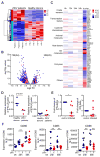Transcriptional Changes during Naturally Acquired Zika Virus Infection Render Dendritic Cells Highly Conducive to Viral Replication
- PMID: 29262327
- PMCID: PMC5751936
- DOI: 10.1016/j.celrep.2017.11.087
Transcriptional Changes during Naturally Acquired Zika Virus Infection Render Dendritic Cells Highly Conducive to Viral Replication
Abstract
Although dendritic cells are among the human cell population best equipped for cell-intrinsic antiviral immune defense, they seem highly susceptible to infection with the Zika virus (ZIKV). Using highly purified myeloid dendritic cells isolated from individuals with naturally acquired acute infection, we here show that ZIKV induces profound perturbations of transcriptional signatures relative to healthy donors. Interestingly, we noted a remarkable downregulation of antiviral interferon-stimulated genes and innate immune sensors, suggesting that ZIKV can actively suppress interferon-dependent immune responses. In contrast, several host factors known to support ZIKV infection were strongly upregulated during natural ZIKV infection; these transcripts included AXL, the main entry receptor for ZIKV; SOCS3, a negative regulator of ISG expression; and IDO-1, a recognized inducer of regulatory T cell responses. Thus, during in vivo infection, ZIKV can transform the transcriptome of dendritic cells in favor of the virus to render these cells highly conducive to ZIKV infection.
Keywords: AXL; IDO-1; RNA-seq; SOCS3; Zika virus; acute infection; dendritic cells; flavivirus; interferon stimulated genes.
Published by Elsevier Inc.
Conflict of interest statement
The authors declare that no competing interest exists.
Figures





References
MeSH terms
Substances
Grants and funding
LinkOut - more resources
Full Text Sources
Other Literature Sources
Medical
Molecular Biology Databases
Research Materials
Miscellaneous

